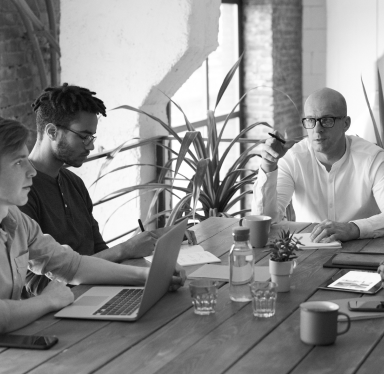Four Steps to Implementing Continuous Improvement Ways of Working From a Standing Start
Whether you are aiming to create a long-term culture of continuous improvement or seeking improvements in efficiency or customer service, the operational team ways of working in your business play a huge role in successful delivery regardless of industry. This blog will help you implement Continuous Improvement (C.I.) Ways of Working within a team using a method which is scalable across the organisation, sustainable and can be mobilised easily.

Step 1: Define the team purpose
This can be achieved through a facilitated session with all members of an operational team. The team should define their purpose and this involves answering questions such as;
- Why does the team exist?
- What is the core purpose of the team?
- What does success look like?
These are simple questions but that may be difficult to answer and different team members may have different opinions. Ideally a team purpose will be no more than two sentences, preferably one.
An example of a Team Purpose for an Accounts Payable Team in a Finance Department might be;
‘To pay suppliers within the agreed payment terms for the goods and services received’
The whole team should be involved in creating their team purpose and a consensus reached on the definition.

Step 2: Creation of purposeful performance measures
This exercise could directly follow step 1 in the same workshop and will also require facilitation. This is the practical creation of the team performance measures and possibly the most crucial step in their C.I. journey as from my experience performance measures will strongly influence the focus of the team.
The performance measures will vary greatly depending on the purpose of the team, but ideally will;
- Be directly linked to the team purpose
- Show whether performance is improving or declining over a period of time
- Show clearly current performance against a target or expected outcome
- Be accessible to measure through available data
- Help the team to seek improvement / act
An important point here is we are creating measures which focus on the service delivered, not evaluating any individual’s performance. We are aiming to promote team problem solving, not monitor individuals.
The team should have both lead and lag indicators for each performance measure. A lag indicator measures something that has already happened and a lead indicator is something that will influence the achievement of the lag. The team should be focus more on the lead indicators as they are more likely to influence them.
If we continue the theme of using an Accounts Payable Team as an example a lag indicator might be;
% Suppliers Paid on Time
There are likely to be lead indicators that strongly influence whether the organisation pays their supplier on time. These might be;
% Invoices Received on Time
% Goods Receipted on Time
If the team focuses on improving the two lead indicators, the lag measure logically will also improve.
A range of visuals should be used to bring performance measures to life. This could be line graphs, charts, colour coded data tables etc.

Step 3: Designing performance boards and implementing team huddles
Again a facilitated workshop with the whole team is a the ideal starting point to design a visual performance board which works perfectly for the team.
The board should be visible to all team members and would ideally be a physical board. For teams that are located in multiple locations, digital performance boards can be used effectively.
Ideally the team would create innovative ideas for their board. However the most typical/generic elements for a performance board may include;
- Team Name & Purpose
- Individual status that could be linked to their current workload e.g. amber, green, red (Some teams like to have their own fun way of doing it such as selecting emojis
- Visual performance measures created in step 2
- Actions – the recording and reviewing of actions. (These actions should be above standard BAU tasks but more the actions that are linked to identified problems or out of the ordinary tasks)
- Team Successes
- ‘On the Radar’ – keeping the team in the loop of upcoming changes/events
- Projects Status – the projects that they are progressing
- Root-cause problem solving – the key problems currently affecting the team and the stage of resolution
- Strategic Deployment – how the team are tracking against their strategic objectives (more suitable for teams mature with C.I.)
A Huddle is a session where the team comes together to review performance, plan for the day and progress problem solving activity.
I would recommend daily huddles of 15 mins for teams with high volume operational work and 30 mins for teams with lower volume work (but no less than 2 huddles per week). The Huddle facilitator should be on a rotational basis. Ideally three roles would be in play including a huddle leader, a timekeeper and a scribe creating actions to go on the board.
Teams benefit greatly from receiving feedback and ongoing coaching to develop their huddles and problem-solving activity over a period of time.
Step 4: Problem Solving
This includes both simple every day problem solving and complex root cause problem solving.
Problem solving naturally follows the steps 1-3 as teams will easily identify problems that restrict them from achieving their goals which they are monitoring on their visual board and reviewing in their huddles. Actions are created at every huddle with owners and dates assigned and older actions are reviewed and removed when complete. Post-it notes are the most commonly used method for this.
Each team should always have 1 key problem they are working on, which is likely to involve an element of complexity. This problem may require collaboration with other teams and departments to solve. The team will need to use a Root Cause Problem Solving Methodology that will help them follow a structure, using different tools and techniques to properly define the problem, identify the root cause and choose & implement an appropriate solution.
An experienced problem solving facilitator is required to support a group through the methodology and tools and ensure discipline is kept to solve root causes rather than just symptoms.
Other points to consider
Of course there are many other steps in the journey to mature the C.I. ways of working however these four simple steps applied widely across the whole organisation can really put you on course towards changing behaviours and culture.
There is an investment in time and expertise required (you may have experience in-house) typically with an initial 1-day workshop/training session for steps 1-3, a separate training session and workshop facilitation for step 4 and coaching support periodically thereafter. E-Learning can also be useful prior to the workshops and training sessions to introduce the C.I. concepts.
I will leave you with three further tips to making these 4 steps a success;
- If possible, initially take each team to see a successful board from another team/organisation, this can help them see what is possible and put things into practical context
- Create a C.I. maturity assessment that will help the organisation track progress of each team over a period of time and identify the required coaching support and best practice teams
- Senior Leaders must be engaged and regularly visit teams, asking questions and offering support. The principle of Transparency needs to be role-modelled to allow teams to feel safe to display problems and true performance
If you would like any advice on starting your CI journey please book a meeting with me and I would be happy to talk.

